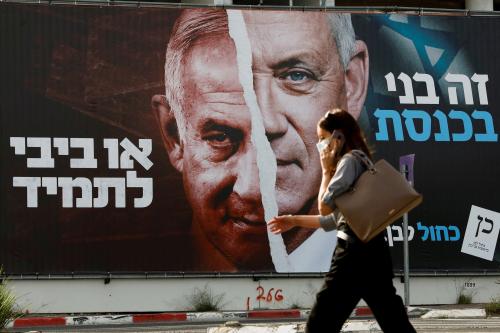On May 15, Israeli Defense Minister Yoav Gallant issued a dramatic challenge to his own prime minister, Benjamin Netanyahu. Speaking for the military he oversees, Gallant, a retired general, described to the Israeli public a glaring lack of strategy in Israel’s operation in the Gaza Strip and pointed explicitly to the man responsible: Netanyahu. He detailed how the security establishment had prepared plans for the “day after” Hamas was defeated in Gaza, only to be rebuffed by Netanyahu. The prime minister not only rejected these plans, famously ruling out the Palestinian Authority (PA) in its current form as a partner for governing Gaza after Hamas, but refused to deliberate any other alternatives. His chosen strategy, as usual, was no strategy.
Netanyahu’s non-strategy has failed even on its own terms. Without an alternative governing structure, Hamas can reconstitute itself, and already its militants have returned to previously cleared areas. Unless an alternative vision for Gaza’s governance is promoted, Israel could find itself conducting continued military operations for months or years to come. And without a humanitarian and diplomatic path forward, Israel cannot begin to mend the generational damage this war has done to Israel’s reputation among the publics in many parts of the world.
An alternative path forward
What might they have done instead? Israel’s leaders should have set a clear strategic vision for the future of a Gaza free from Hamas, and from this vision established operational goals. The vision would have not only spelled out who cannot rule Gaza, but who should. Given a menu of bad-to-terrible options, the choice is clear: The PA, with proper reform, or people close to it. This would have allowed Israel, the United States, the PA, and others to plan for the administration of civilian affairs in Gaza in the short and long term.
Israel, in other words, should have followed the principles of counterinsurgency campaigns, as learned by the American military, for example, and entered Gaza with a practical plan for civil administration. Indeed, the U.S. administration has repeatedly urged the Israelis to learn from America’s own mistakes, as President Joe Biden put it already in October. Learned the hard way, American counterinsurgency necessitates not only clearing an area militarily but seriously planning for how to hold it, stabilize it, and allow it to recover.
A campaign that had a clear vision—any viable vision—for the day after in Gaza would have been far more cautious about civilian casualties and the physical devastation it wrought. Netanyahu should and could have declared that a visible Israeli distinction between Hamas and Gaza’s civilian population was both a moral and strategic imperative, overriding reckless statements from some Israelis to the contrary. Israel could have owned the humanitarian effort from the early days of the campaign and flooded the Gaza Strip with aid, affording it operational and public advantages as well as serving the dire humanitarian need in Gaza.
To be sure, it would have been politically difficult to order massive Israeli aid into Gaza in the immediate days after October 7. Israelis viewed Gaza as a foreign statelet that had attacked them, where their hostages were being abused at that time, and still are today. Israelis had also been appalled by the participation of some Gazan civilians in the October 7 kidnappings, following Hamas fighters entering Israel, and by the scenes of jubilation in Gaza in the wake of the massacre and the parade of hostages and dead bodies. And yet that is precisely when leadership is tested: When the politics are hard, when emotions point to action against one’s interest, where a leader’s very political future is at stake, and when the good of the country and moral imperatives demand strategic action.
Taken together, this effort would have also done far more for Israel’s international standing than any public relations campaign could ever hope to achieve. It would have allowed Israel’s leaders to emphasize Hamas’s culpability in Gazans’ suffering and the logic of Israel’s military goals.
Without a political aim, no military campaign can succeed by definition. Indeed, that Netanyahu had no day-after strategy greatly complicated the American attempt to promote a postwar plan for Gaza as part of an effort toward regional integration and Saudi-Israeli normalization. Secular Palestinian actors, whether the PA or people in its orbit, would be crucial to enlisting support from the Arab Gulf states and acting as agents of change on the ground. Yet Netanyahu rejected their involvement. Now, as Gallant has implied, Netanyahu is contemplating a civil administration led by the Israeli military. While this may have been a necessary stopgap in the first days of the war, as the ground operation began, today it is a recipe for renewed long-term Israeli occupation in the Gaza Strip, 16 years after Israel withdrew from it.
The need to think strategically
In the early days after October 7, the Israeli cabinet handed its military a primary goal for its operation: to destroy Hamas’s military capabilities and remove it as the governing body in the Gaza Strip—able to organize, arm, train, and prepare to invade Israel again with thousands of troops and carry out massacres in Israeli towns and villages. The prime objective reflected a simple yet deeply felt sense among Israelis that what happened that day must never be allowed to happen again, no matter how difficult the task may be or how harsh the opprobrium that emerges. Bombastic rhetoric notwithstanding, the operational goal was never the eradication of Hamas as an idea or a cause, but its removal as a quasi-state able to threaten Israel’s borders. This goal entailed enormous cost—first and foremost to Gazans—but it was a goal that was at least technically achievable.
This objective had a corollary: If a terrorist organization with declared and proven aims to fight Israel and kill Israelis cannot be allowed to govern a statelet abutting Israeli towns, the same applied to the northern Israeli border, where Hezbollah is deployed and where it has in the past dug cross-border tunnels and declared its intention to fight the next war in Israel.
No less emotive, if more time-bound, was the objective of releasing the some 250 Israeli hostages and captives taken on October 7, especially the most vulnerable among them, including babies and the elderly.
The tension between these objectives was clear from the start. Releasing the bulk of the hostages, used as human shields by Hamas leaders, necessitated a deal with Hamas. Israelis remain divided on whether to prioritize the fight against Hamas or the release of hostages, to the exclusion of the bigger picture. The failure to achieve these goals, so far, does not stem from the tension between them. It stems, more than anything, from a lack of overall strategy. Hamas cannot be defeated if a vacuum is left in its wake. Strategy is not a luxury. It is essential for deriving one’s tactics and operational conduct from day one.
Many Israelis acknowledge both the devastation in Gaza and the historic damage to Israel’s international standing created by the pursuit of these goals. Yet Israelis often refer to these outcomes as unavoidable consequences of the events that triggered the war. Israel had no choice but to remove Hamas after the organization had proven its intent and capacity to carry out such atrocities, they argue, and removing Hamas from such a dense urban population, for which Hamas showed no concern, made the campaign necessarily devastating. Had it not been such a daunting task, Israel would have removed Hamas from power years ago.
Yet even from the Israeli perspective alone, a campaign to remove Hamas for the long term necessitates—even now—massive efforts to both ameliorate the humanitarian crisis in the Gaza Strip and to fill the administrative vacuum left by the war and the removal of Hamas governing infrastructure.
It is extremely late, and yet these same principles still apply. Adopting a sound strategy even now can not only ease some of the terrible aspects of the current war but also advance Israel’s own original operational goals for this campaign. The recent shift in Israeli policy on the entry of aid, following American pressure, is one element of a better approach. A concerted effort to work with secular Palestinian actors, including the PA, would be a second. But the key would be more fundamental still: Defining a strategic political goal that envisions a reconstructed Gaza Strip, reintegrated with the West Bank, under secular Palestinian leadership that can begin to regain its people’s trust and work with Israel. It would be a tall order, and likely an impossibility for Netanyahu at this stage, but without it, success will remain elusive.
-
Acknowledgements and disclosures
The author would like to thank Kevin Huggard for his assistance on this article.






Commentary
Israel’s strategic choice
May 17, 2024